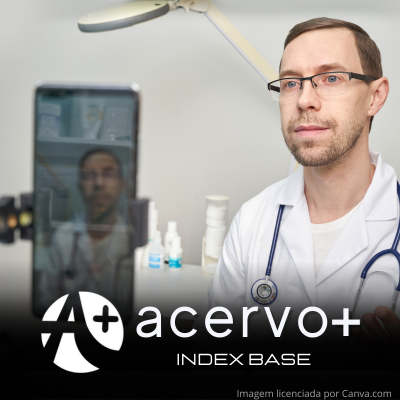Uso das mídias sociais na perspectiva de estudantes de odontologia
##plugins.themes.bootstrap3.article.main##
Resumo
Objetivos: Avaliar a percepção dos estudantes de Odontologia sobre o uso das mídias sociais no processo de ensino-aprendizagem. Métodos: Um questionário foi aplicado aos estudantes do sexto ao oitavo período, contendo 14 perguntas sobre acesso à internet, redes sociais, tempo de uso, finalidades, benefícios e malefícios, além do uso das mídias no processo de ensino-aprendizagem. Foram utilizados dados de frequência e o teste qui-quadrado para comparação entre os gêneros. As questões abertas foram avaliadas qualitativamente. Resultados. Dos 85 estudantes avaliados, 77,6% eram do gênero feminino, com idade média de 23,1 anos. Dos alunos participantes, todos possuíam acesso à internet e relataram usar WhatsApp e Instagram. Em relação ao tempo de uso, 36,5% afirmaram fazer uso dessas mídias há mais de 10 anos. Quanto à finalidade do uso dessas mídias, 65,9% relataram o uso para aprendizado odontológico. Como benefício, 81,2% apresentaram a troca de opiniões sobre assuntos diversos e 83,5% destacaram a distração ao estudar como principal malefício. Não houve diferença significativa entre os gêneros. Conclusão: As mídias sociais são vistas positivamente no aprendizado por oferecerem recursos adicionais, mas o tempo excessivo é um ponto negativo, sendo essencial equilibrar a produtividade e o uso saudável para evitar o risco de vício.
##plugins.themes.bootstrap3.article.details##
Copyright © | Todos os direitos reservados.
A revista detém os direitos autorais exclusivos de publicação deste artigo nos termos da lei 9610/98.
Reprodução parcial
É livre o uso de partes do texto, figuras e questionário do artigo, sendo obrigatória a citação dos autores e revista.
Reprodução total
É expressamente proibida, devendo ser autorizada pela revista.
Referências
2. ALMOMANI EY, et al. The influence of coronavirus diseases 2019 (COVID-19) pandemic and the quarantine practices on university students' beliefs about the online learning experience in Jordan. Frontiers in Public Health, 2021; 8: e595874.
3. ALQARYAN S, et al. Smartphones and professionalism: a cross-sectional study on interns and final-year medical students. International Journal of Medical Research & Health Sciences. 2016; 5 (9): 198-202.
4. Al-SHARQUI LMO, et al. Perceptions of social media as a learning tool: a comparison between arts and science students. International Journal of Social Media and Interactive Learning Environments. 2016; 4(1): 92-108.
5. AL-SHARQUI LMO, HASHIM K. University students’ perceptions of social media as a learning tool. The Journal of Social Media in Society, 2016; 5(1): 65-88.
6. ARNETT MR, et al. A school-wide assessment of social media usage by students in a US dental school. British Dental Journal. 2014; 217 (9): 531-5.
7. BRASIL. Diário Oficial da União. 2025. Disponível em: https://www.in.gov.br/en/web/dou/-/lei-n-15.100-de-13-de-janeiro-de-2025-606772935. Acessado em: 4 fevereiro de 2025.
8. CHAN TM, et al. Social media in knowledge translation and education for physicians and trainees: a scoping review. Perspectives on Medical Education. 2020; 9 (1): 20-30.
9. CHRETIEN KC, TUCK MG. Online professionalism: a synthetic review. International Review of Psychiatry. 2015;27(2):106-117.
10. DIAS DA SILVA M, et al. Who is providing dental education content via YouTube? British dental journal. 2019; 226 (6): 437-440.
11. HAMM MP, et al. Social media use by health care professionals and trainees: a scoping review. Academic medicine: journal of the Association of American Medical Colleges. 2013; 88 (9): 1376-83.
12. HASHIM K, et al. University students’ perceptions of social media as a learning tool: a science discipline perspective. Advances in Social Sciences Research Journal. 2017: 4 (19): 19-31.
13. JUNCO R, CHICKERING AW. Civil discourse in the age of social media. About Campus: Enriching the Student Learning Experience. 2010; 15(4): 12-8.
14. KAPLAN AM. Social media, the digital revolution, and the business of media. International Journal on Media Management. 2015: 17(4): 197-199.
15. KENNY P, JOHNSON IG. Social media use, attitudes, behaviours and perceptions of online professionalism amongst dental students. British Dental Journal.2016; 221(10): 651–55.
16. LATIF MZ, et al. Use of smartphones and social media in medical education: trends, advantages, challenges and barriers. Acta Informatica Medica. 2019: 27(2): 133-138.
17. LIU Y. Social media tools as a learning resource. Journal of Educational Technology Development and Exchange. 2010; 3(1): 101-14.
18. MCANDREW M, JOHNSTON AM. The role of social media in dental education. Journal of Dental Education. 2012; 76(11): 1474-81.
19. NAGUIB GH, et al. Social media usage and self perception among dental students at King Abdulaziz University, Saudi Arabia. Journal of Medical Education for Future Demands. 2018; 17(2): 109-19.
20. PEDROUZO SB, KRYNSKI L. Hyperconnected: children and adolescents on social media. The TikTok phenomenon. Archivos Argentinos de Pediatría. 2023; 121(4): 1-6.
21. RAJEH MT, et al. Social media as a learning tool: dental students’ perspectives. Journal of Dental Education. 2020; 85(4): 513-20.
22. ROGOWSKA AM, CINCIO A. Procrastination mediates the relationship between problematic Tik Tok use and depression among young adults. Journal of Clinical Medicine. 2024 ;13(5): 1-17.
23. RUKAVINA TV, et al. Dangers and benefits of social media on e-professionalism of health care professionals: scoping review. Journal of Medical Internet Research. 2021; 23(11): 1-25.
24. SOLTANIMEHR E, et al. Effect of virtual versus traditional education on theoretical knowledge and reporting skills of dental students in radiographic interpretation of bony lesions of the jaw. BMC Medical Education. 2019; 19 (1): 233.
25. STELLEFSON M, et al. Evolving role of social media in health promotion: updated responsibilities for Health Education Specialists. International Journal of Environmental Research and Public Health. 2020: 17 (4): 1153.
26. THOMPSON SH, LOUGHEED E. Frazzled by Facebook? An exploratory study of gender differences in social network communication among undergraduate men and women. College Student Journal. 2012; 46(1): 88-98.
27. WENG CB, et al. Gray matter and white matter abnormalities in online game addiction. European Journal of Radiology. 2013; 82(8): 1308-12.
28. ZAIDI A, et al. University students’ perceptions of YouTube usage in (ESL) classrooms. International Journal of Academic Research in Business and Social Sciences. 2018; 8 (1): 534-545.

